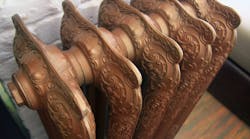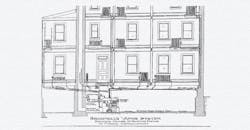Latest from Hydronics
Feedwater Economizer To Save You Money
Sponsored
One of my favorite customer’s crew had recently replaced a leaking steam boiler with an exact replacement. He told me that the new boiler seemed to be working fine, but now the homeowner was complaining about a few radiators not working. This happens sometimes. A homeowner has a new boiler installed and then starts telling the installing contractor about problems that just started after the installation. Now, sometimes that is true, and sometimes it isn’t.
We decided that a site visit was needed. Once he told me the address, I recognized it was in a neighborhood that has a lot of interesting hot water and steam boiler systems. The houses were built from the very early 1900’s to 1930 or so by some of the wealthiest people in town. I could tell when I pulled up that this house was built in a grand manner.
When I got inside, the owner of the house had plenty to say. She is a retired doctor who has lived there for a long time and knows the home’s history. Turns out the place was built in 1912. Looking around, I saw it was a one pipe steam system with ornate radiators. As I suspected, there was something interesting on both sides of the radiator.
On the inlet side of the radiator was a huge original pneumatic operator, which is very unusual for a one pipe system, and more unusual for a residential application. With a control valve on each of the radiators, the original owner could set the temperature of each room. Again, very unusual for a steam boiler system of that era to have individual room control.
On the other side of the radiator, where you usually see a radiator vent that discharges air into the room, is an air valve, which looks like a miniature radiator trap. It mounts in the same place as a regular steam air vent, about a third of the way up. However, instead of allowing the air to vent into the room, the air valve’s discharge is hard piped to the basement and a separate return pipe system. See page 83 of my Field Guide (available as a free download at steamupairoutwaterback.com) for more details.
The contractor and I went to the basement to meet his service tech, who also had plenty to say. My eyes went immediately to the exposed piping. Sure enough, right alongside the asbestos covered steam distribution mains were smaller than usual return pipes. They started off as ¼” pipe from the radiators and increased to 1” when we finally found the boiler room.
This boiler room had it all. The original air compressor for the pneumatic controls was still there in its 1912 glory. There was a nice deep pit with the original coal-fired steam boiler that was the size of a work van. Not in the pit was the new gas fired steam boiler, hooked up to the original header from the original gas boiler. Yes, in 1912, it was fairly common in the well-to-do neighborhoods to have both a coal-fired boiler and a gas-fired boiler in the same house.
Of course, what I was looking for was the end of those unusual return lines. They combined into one pipe that terminated above the back of the coal boiler near the chimney. What I was trying to determine was the path of the air out of the radiators, since it didn’t discharge into the rooms above like a normal one pipe system. Right at the end of the common return line was an air vent that the tech told me was spitting water.
Why would an air vent on a return line that should only be full of air have any water present? First I suspected that the steam pressure in the boiler was stacking up the water since this was a gravity return system. Normally the “A” dimension determines the height of the water in the return on a one pipe system (see page 90 of the guide). However, with the air valves acting as steam traps, the “B” dimension would come into play (see page 96 of the guide). But of course it couldn’t be that simple. I found that the return line wasn’t connected to the boiler AT ALL. Time to throw out the book.
After the vent, the return line elbowed down to 12” from the floor, looped back up to just below the level of the return main, and then elbowed back down to a drain in the floor of the pit. Just like the tech reported, the air vent started spiting water once the boiler fired up. I had the tech remove the vent, and a plug at the bottom of the loop. He was going to monitor the boiler room while we went upstairs to take a tour of the radiators that weren’t working.
We found that most of the radiators that weren’t working were now getting steam. But, we were also checking for the operation of those air valves, since water was coming from somewhere. We found air valves that were not closing off to the presence of steam after 108 years of service. They were allowing steam to get into the return lines where it condensed into water and ran downhill to the air vent at the end.
Back in the basement, the tech found that the vertical portion of the return line after the air vent was clogged, which explained why water was coming out of the vent. It didn’t have any other place to go. We decided to clear the clog and check to see if repair kits for the air valves would be available. Unfortunately, I couldn’t find any parts, which switched us to plan B, replacing the faulty air valves with regular air vents and capping off their return lines.
The very few systems I have seen with air valves were in office buildings with vacuum pumps in the basement. Since there wasn’t one of those in this vintage boiler room, I think that the original end of the return line was into the chimney, where the draft of the chimney would pull a non-mechanical slight vacuum on the return line, pulling the air out. That technique was used back in the early 1900’s by some manufacturers. The copy of a copy of a page from the archives shows the “air pipe to chimney”, explained as “this creates a pull and a partial vacuum through the entire return system”.
I got a call from Al in Cleveland last month. He’s my only fan and wanted me to address a safety issue regarding steam. If you are opening a steam valve, take it slow. Never open steam valves quickly, because bad things can happen to you or to the equipment. Be safe out there.
The article title is from the lyrics of a Neil Young and Crazy Horse song, Double E, from his rock opera Greendale, which bemoans the passage of time. With my job, and with yours, we get to look back in history to discover how these state of the art over a hundred years ago steam systems worked. Good luck with that sometimes.
Patrick Linhardt is a thirty-five-year veteran of the wholesale side of the hydronic industry who has been designing and troubleshooting steam and hot water heating systems, pumps and controls on an almost daily basis. An educator and author, he is currently Hydronic Manager at the Corken Steel Products Co.
Patrick Linhardt
Patrick Linhardt is a forty-one-year veteran of the wholesale side of the hydronic industry who has been designing and troubleshooting steam and hot water heating systems, pumps and controls on an almost daily basis. An educator and author, he is currently Hydronic Manager at the Corken Steel Products Co.



